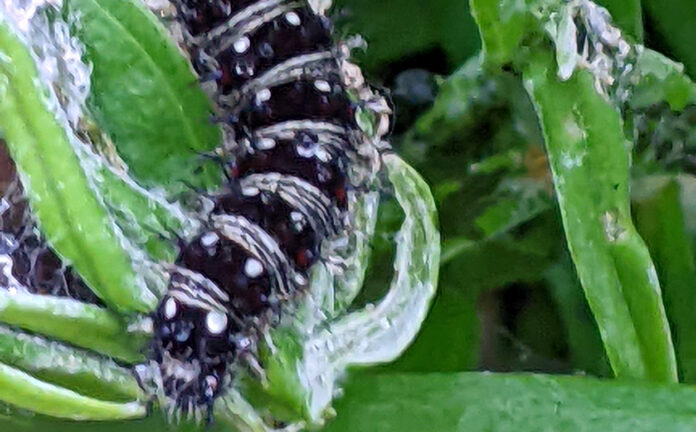Submitted by Debby Walters
WOODVILLE, WI – While perusing my garden the other day, I noticed that the Pearly Everlasting is in really rough shape, it is decimated. It is a native plant. The top leaves of every plant are bent over and wrapped with silken thread. Lots of little black dots appear on the plant (poop or frass as it is called when from a caterpillar). Upon closer examination there are caterpillars of all sizes covering the plants. So, the research begins, those caterpillars are American Lady butterflies (Vanessa virginiensis).
These caterpillars are unique because they create nests of the leaves to protect themselves. They take cover on sunny days and come out in the evening or on overcast days to feed. In my garden it doesn’t seem to make a difference, they are gobbling up my plants. Like monarchs, they need a host plant . . . there are two possibilities: Pearly Everlasting and Pussytoes. Pearly everlasting is also the host plant for Painted Lady butterflies (Vanessa cardui), but I’ve not spotted those caterpillars . . . yet.
Like monarchs the American Lady also migrate, but not as far. They head to the southern U.S. each fall and their descendants return north each spring.
Soon the caterpillars will make their chrysalis. The chrysalis are green or gray, about ¾” long, and look as though they will be very well camouflaged. As far as the Pearly Everlasting goes, it should recover and look better later in the season.
Pearly Everlasting (“Anaphalis margaritacea”) has silver green foliage and clusters of small white flowers on top. It is about 2 feet tall. Apparently, it used to be used in dried floral arrangements. I planted it primarily for its foliage and because it was a native plant and was not aware of its host plant capabilities. A chewed-up plant is evidence that insects/critters are enjoying the garden. The whole purpose of planting native plants!






